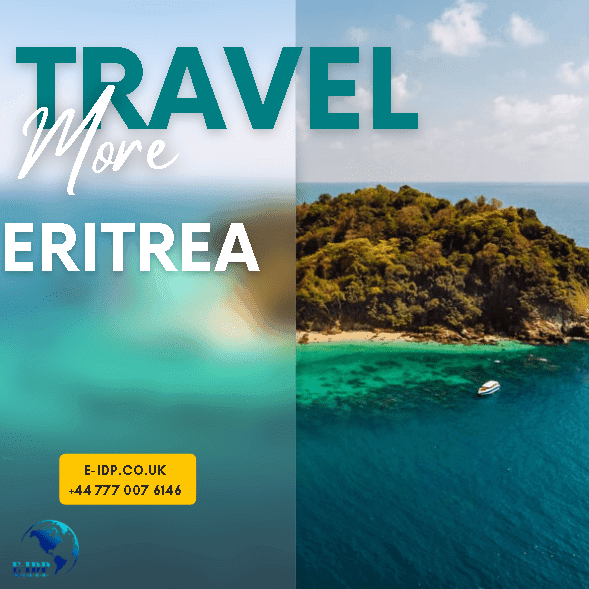Eritrea Travel Guide, IDP apply online Eritrea, International Driving Permit Eritrea, International Driving licence Eritrea, International Driving license Eritrea
Eritrea Travel Guide: Navigate to Africa’s Horn
Eritrea, a hidden gem on the northeastern coast of Africa, is a destination that offers a unique blend of natural beauty, rich history, and cultural diversity. Located along the Red Sea, Eritrea is bordered by Sudan, Ethiopia, and Djibouti, making it a crossroads of various civilizations throughout history. From the modernist architecture of Asmara to the untouched beaches of the Dahlak Archipelago, Eritrea is an undiscovered paradise for travelers seeking a more off-the-beaten-path adventure. This Eritrea Travel Guide will help you navigate the best attractions, cultural experiences, and practical information for visiting this fascinating country.
Why go to Eritrea?
Eritrea is a country where history and nature intertwine. Despite its relatively small size, Eritrea offers a wide range of experiences for the adventurous traveler. The country boasts ancient ruins, picturesque cities with Italian colonial architecture, and some of the most pristine coastlines in Africa. Its people, who belong to various ethnic groups such as the Tigrinya, Tigre, and Afar, are warm and welcoming, eager to share their culture and traditions.
Eritrea’s diverse landscapes range from the rugged highlands of the central region to the coastal plains and desert areas in the east. The country’s historical significance, combined with its natural beauty, makes Eritrea an attractive destination for history buffs, nature lovers, and cultural enthusiasts alike.
Best Time to go to Eritrea
Eritrea has a varied climate due to its geography, and the best time to visit depends on which part of the country you plan to explore. Generally, the best time to visit is during the cooler months from October to March, especially if you’re planning to spend time in Asmara or the highlands. During this period, the weather is pleasant, and it’s ideal for sightseeing and outdoor activities.
The coastal regions and lowland areas, such as Massawa and the Dahlak Archipelago, can get extremely hot during the summer months, so it’s advisable to visit these areas between November and April when temperatures are more moderate.
Top Amusements in Eritrea
Asmara: Eriterea Capital
Eritrea’s capital, Asmara, is often referred to as “Little Rome” due to its incredible collection of Italian colonial architecture. This UNESCO World Heritage site is renowned for its Art Deco buildings, wide boulevards, and a laid-back atmosphere that makes it feel more like a Mediterranean city than an African capital.
- The Fiat Tagliero Building: One of the most famous examples of futurist architecture in Asmara, this striking building was designed in the 1930s to resemble an airplane. It’s an iconic symbol of the city’s unique architectural heritage.
- Catholic Cathedral of Asmara: Built in the neo-Romanesque style, the Catholic Cathedral of Asmara is a beautiful reminder of the city’s Italian influence. Visitors can admire its ornate exterior and peaceful interior.
- Asmara’s Markets: A visit to Asmara wouldn’t be complete without exploring its bustling markets. The Central Market offers a variety of local goods, from spices and coffee to handmade crafts and textiles, giving visitors a glimpse into the daily life of Eritreans.
Massawa: Red Sea Pearl
Located on the coast of the Red Sea, Massawa is a historic port city that has played a vital role in the region’s maritime history. With its Ottoman, Egyptian, and Italian colonial architecture, Massawa is a city that reflects the influences of its various rulers over the centuries.
- Old Town of Massawa: The old town is a maze of narrow streets and stone buildings, many of which date back to the Ottoman era. Walking through the streets of Massawa, you can see beautiful mosques, arches, and Italian-style buildings that have stood the test of time.
- The Imperial Palace: Built during the reign of Emperor Haile Selassie, this once-grand palace now stands in ruins but offers stunning views of the Red Sea and remains a symbol of Eritrea’s royal past.
- Massawa’s Beaches: Just outside the city, visitors can relax on the pristine beaches of the Red Sea, which are ideal for swimming, snorkeling, and diving.
The Archipelago of Dahlak : Red Sea Islands
For travelers looking to escape to a remote paradise, the Dahlak Archipelago is a must-visit destination. Comprising more than 100 islands, the archipelago is located just off the coast of Massawa in the Red Sea. The islands are largely uninhabited, and their crystal-clear waters and vibrant marine life make them a haven for snorkeling and diving enthusiasts.
- Diving and Snorkeling: The warm waters of the Red Sea are home to an abundance of coral reefs, colorful fish, and marine creatures such as dolphins and sea turtles. The reefs around the Dahlak islands are some of the most pristine in the world, making them ideal for underwater exploration.
- Island Hopping: Visitors can take boat tours to explore the various islands in the archipelago. Some of the most popular islands include Dahlak Kebir, the largest island, and Dissei Island, known for its secluded beaches and rich marine biodiversity.
Qohaito: Old Ruins and Archaeological Wonders
Located in the southern part of Eritrea, Qohaito is an ancient archaeological site that dates back to the Aksumite Kingdom. The site, which is believed to have been an important center of trade and religion, offers visitors the chance to explore ruins of ancient temples, tombs, and rock art.
- The Temple of Mariam Wakino: One of the most well-preserved structures at Qohaito, this temple is dedicated to the ancient goddess Mariam Wakino and offers insight into the spiritual practices of the region’s early inhabitants.
- Adulis: Located near the coast, the ancient city of Adulis was once a major trading port in the Red Sea region. Visitors to the site can see remnants of ancient buildings and artifacts that reflect the city’s significance in ancient maritime trade.
Keren: History and Nature
Nestled in the highlands north of Asmara, the town of Keren is a charming destination that offers a mix of natural beauty and historical significance. Known for its vibrant markets and beautiful landscapes, Keren is a great place to experience the Tigrinya culture.
- The Keren War Cemetery: This cemetery honors the soldiers who fought in the Battle of Keren during World War II. It’s a peaceful and somber reminder of Eritrea’s role in the war.
- Camel Market: Keren is famous for its lively camel market, where local herders gather to trade camels, livestock, and other goods. It’s an authentic experience that provides a glimpse into the traditional way of life in the region.
Traditions of Eritrean
Eritrean culture is a reflection of the country’s diverse population, with influences from its various ethnic groups, including the Tigrinya, Tigre, Afar, and Bilen. The country’s unique blend of traditions, languages, and spiritual practices makes it a culturally rich destination.
Languages
The official languages of Eritrea are Tigrinya, Arabic, and English, although there are numerous local languages spoken throughout the country. Tigrinya is the most widely spoken language, particularly in the highland regions.
Religion
Eritrea is religiously diverse, with Christianity and Islam being the two dominant religions. The majority of Christians in Eritrea belong to the Eritrean Orthodox Church, while Islam is predominantly practiced in the coastal and lowland regions. Religious festivals and practices are an integral part of daily life in Eritrea, and visitors may have the opportunity to witness traditional religious ceremonies and events during their stay.
Eritrean Food
Eritrean cuisine is influenced by both African and Mediterranean traditions, with a strong emphasis on spices, grains, and fresh ingredients. Some of the most popular dishes include:
- Injera: A staple food in Eritrea, injera is a sourdough flatbread made from teff flour. It’s often served with a variety of stews, such as zigni (spicy meat stew) or alicha (vegetable stew).
- Tsebhi: A spicy stew made with either lamb, beef, or chicken, tsebhi is flavored with berbere spice mix and served with injera.
- Kitcha Fit-fit: A traditional Eritrean breakfast dish made from shredded flatbread mixed with spiced butter and berbere, often enjoyed with a side of yogurt or milk.
Travelers Useful Info
Going to Eritrea
The main entry point for international travelers is Asmara International Airport. Several airlines, including Ethiopian Airlines and Turkish Airlines, offer regular flights to Asmara from major international hubs. Visitors can also enter Eritrea by land from Sudan or Ethiopia, although travel restrictions may apply due to political tensions in the region.
Visas
Most travelers will need a visa to enter Eritrea. Tourist visas can be obtained from Eritrean embassies or consulates in your home country. It’s advisable to apply for a visa well in advance of your trip, as the process can take time.
Currency
The official currency of Eritrea is the Eritrean Nakfa (ERN). ATMs are not widely available in Eritrea, so it’s recommended to bring cash, preferably in US dollars or euros, which can be exchanged for local currency upon arrival. Credit cards are rarely accepted, even in major cities.
Safety
Visitors to Eritrea are advised to have up-to-date vaccinations, including those for yellow fever and hepatitis A. Malaria is a risk in some regions, particularly in the lowlands, so travelers should take anti-malarial medication and use insect repellent. Eritrea is generally a safe country for tourists, but it’s always important to follow local advice and exercise caution when traveling in remote areas.
What you need to rent a car, and how to rent one
As a tourist, you’ll most likely be renting a car (more on that in a bit) for your road trip. Even so, there are certain requirements that you’ll have to check off before you get into it.
- You have to get an International Driver’s Permit. Apply for it online or head to the office — we prefer doing it in person because the queue is pretty short during off-peak hours, and you can get it done on the same day. It’ll cost S$20 and is valid for one year from the date of issue.
- A valid local driver’s license. international driving licence online
- You have to be at least 21 years of age and have held your local licence for a year. A surcharge may be imposed for drivers under the age of 25.
- A passport for identification .
- A credit card in the driver’s name.
How to obtain an international driving permit

The process of obtaining an international driving license directly from an office can be quite challenging and time-consuming. The payment methods involved can also be complex. Therefore, it is recommended to consider applying for an international driving license from IMTA. The application process only takes around 10 to 15 minutes, making it a more efficient option for getting your international driving permit Get Your Online Int’l Driving Permit for the United Kingdom
The necessary details required for the application of an International driving permit include:
– Full Name
– Email & Phone Number
– Current Address
– Place of Birth
– National Driver’s License Number
– National Driver’s License Issued Date & Expiry Date
– Picture of Driver’s License & Your Head Shot Photo for Your IDP
 Eritrea Travel Guide, IDP apply online Eritrea, International Driving Permit Eritrea, International Driving licence Eritrea, International Driving license Eritrea, Eritrea Travel Guide, IDP apply online Eritrea, International Driving Permit Eritrea, International Driving licence Eritrea, International Driving license Eritrea, Eritrea Travel Guide, IDP apply online Eritrea, International Driving Permit Eritrea, International Driving licence Eritrea, International Driving license Eritrea, Eritrea Travel Guide, IDP apply online Eritrea, International Driving Permit Eritrea, International Driving licence Eritrea, International Driving license Eritrea
Eritrea Travel Guide, IDP apply online Eritrea, International Driving Permit Eritrea, International Driving licence Eritrea, International Driving license Eritrea, Eritrea Travel Guide, IDP apply online Eritrea, International Driving Permit Eritrea, International Driving licence Eritrea, International Driving license Eritrea, Eritrea Travel Guide, IDP apply online Eritrea, International Driving Permit Eritrea, International Driving licence Eritrea, International Driving license Eritrea, Eritrea Travel Guide, IDP apply online Eritrea, International Driving Permit Eritrea, International Driving licence Eritrea, International Driving license Eritrea





